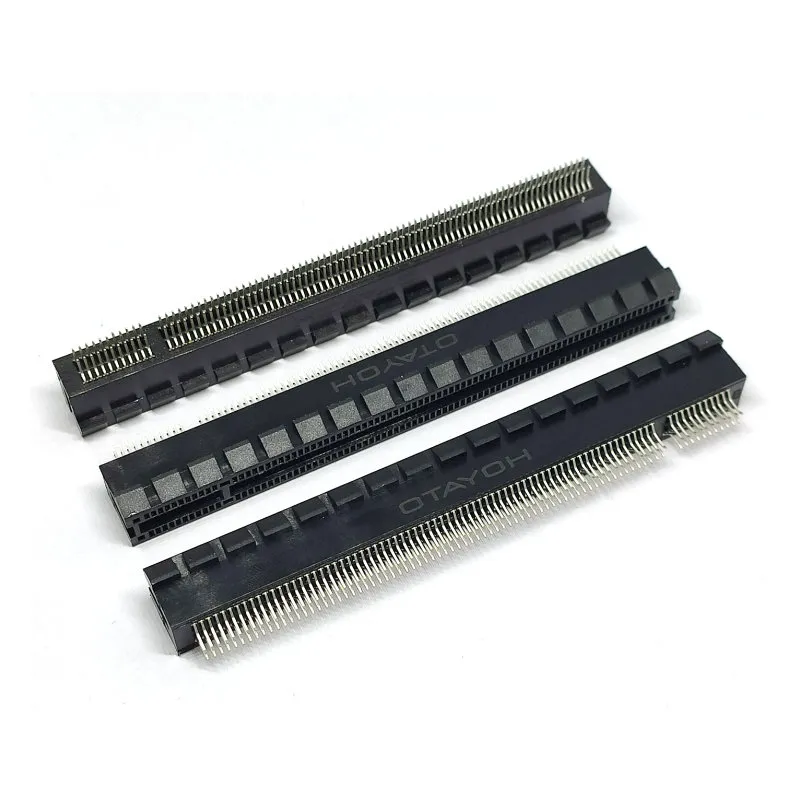

Hot Selling 164 Pin Clamping Plate Type PCIE Express Connector card edge connector
- Part No : PCIECP10-164GX
-
1. Current Rating : 1.1Amps
2. Voltage Rating : 250V AC
3. Contact Resistance : 30m Ohm Max At DC 100m Amps
4. Insulation Resistance : 1000M Ohm Min at DC 500V
5. Withstanding Voltage : 1 Minute At 750V r.m.s Min
6. Operating Temperature Range : -40°C ~ 85°C
Meterials:
1.Insulator:High Temp. Plastic (Nylon 66 UL94V-0)
Color :Black
2.Terminal: Copper Alloy
3.Plating: Selective Gold Plated - Inquiry now
- Products Drawing
Detailed description
PCI-E Power Connector designed to meet the demands of modern computing and gaming systems, this connector ensures your components receive the power they need for optimal performance.
Experience the epitome of reliable and high-speed data connectivity with our hot-selling 164 Pin Clamping Plate Type PCIE Express Connector. This connector is meticulously designed to meet your data connectivity needs across a spectrum of electronic applications.
Key Features:
- Proven Performance: Trusted by professionals and enthusiasts alike, our PCIE Express Connector guarantees reliable and high-performance data connections.
- Clamping Plate Design: The clamping plate type ensures secure connections, reducing the risk of disconnections during operation.
- 164 Pin Configuration: With 164 pins, this connector offers versatile connectivity options for data and power requirements in various electronic devices.
- Quality Craftsmanship: Crafted with precision engineering, this connector meets industry standards for durability and performance.
Why Choose Us?
- Quality Assurance: Our connectors are manufactured to the highest industry standards, ensuring a dependable and consistent performance.
- Expert Support: Our experienced team is ready to assist with technical inquiries and provide tailored guidance for your projects.
- Swift Delivery: We offer fast and reliable shipping to ensure your connectors are delivered promptly.
Email: sales08@dghoyato.com
Skype:sales08@dghoyato.com
Understanding Card Edge Connectors: A Comprehensive Overview
Card edge connectors are a fundamental component in the realm of electronics and computing, offering a versatile and efficient means of establishing connections between circuit boards. These connectors are pivotal in modern technology, ranging from personal computers and servers to industrial machinery and consumer electronics. This article delves into the intricacies of card edge connectors, exploring their design, functionality, applications, and future trends.
What is a Card Edge Connector?
A card edge connector is a type of electrical connector used to interface a printed circuit board (PCB) with another board or electronic device. It is designed to make electrical contact with the edge of a PCB, allowing the board to be plugged into a socket or another board. This connection type is widely used due to its simplicity, reliability, and ease of integration.
Design and Structure
Card edge connectors consist of several key components:
– **Edge Contacts:** These are metal contacts that line the edge of the PCB. They are typically made from copper or other conductive materials and are plated with gold or other metals to ensure reliable electrical conductivity and resistance to corrosion.
– **Connector Housing:** The housing or frame holds the edge contacts in place and provides physical protection to the contacts. It is usually made from durable plastic or metal.
– **Mechanical Keying:** To prevent incorrect insertion, card edge connectors often include keying features that ensure the card can only be inserted in one orientation.
– **Mounting Features:** These features help secure the connector to the PCB or the housing. They can include mounting holes, clips, or soldering points.
Types of Card Edge Connectors
Card edge connectors come in various forms, each suited to specific applications:
1. **Standard Card Edge Connectors:** Commonly used in personal computers, these connectors typically adhere to industry standards like PCI (Peripheral Component Interconnect) or ISA (Industry Standard Architecture).
2. **PCI Express (PCIe) Connectors:** An evolution of the standard card edge connector, PCIe connectors offer higher data transfer rates and are used in modern computing for connecting high-speed peripherals.
3. **DIMM (Dual Inline Memory Module) Connectors:** These are used for connecting memory modules to a motherboard. They are designed to support high-speed data transfers and often include features to ensure proper alignment and secure connections.
4. **SCSI (Small Computer System Interface) Connectors:** Used in older systems for connecting peripheral devices, SCSI connectors have been largely replaced by newer technologies but are still found in legacy systems.
5. **Custom Connectors:** Many industries and applications require specialized card edge connectors designed to meet unique requirements. These custom connectors are tailored to specific dimensions, pin configurations, or environmental conditions.
Applications of Card Edge Connectors
Card edge connectors are employed in a wide array of applications:
1. **Computing:** In personal computers and servers, card edge connectors facilitate connections between motherboards and expansion cards such as graphics cards, network cards, and storage controllers. The PCIe connector, for example, is crucial for enabling high-speed data transfer between the motherboard and peripheral devices.
2. **Telecommunications:** In telecommunications equipment, card edge connectors are used in network switches, routers, and base stations to interconnect circuit boards and modules. Their reliability and high-density connection capability are essential for maintaining stable and efficient communication networks.
3. **Industrial Automation:** Industrial machinery and control systems often utilize card edge connectors to link control boards, sensors, and actuators. The rugged design of these connectors ensures durability and reliability in harsh environments.
4. **Consumer Electronics:** Devices such as televisions, gaming consoles, and audio equipment use card edge connectors to interface internal components. Their compact design allows for efficient use of space within these devices.
5. **Automotive:** Modern vehicles incorporate numerous electronic systems, including engine control units (ECUs), infotainment systems, and advanced driver-assistance systems (ADAS). Card edge connectors are used to link these various systems and ensure reliable operation.
Advantages of Card Edge Connectors
Card edge connectors offer several advantages that make them a popular choice for many applications:
– **Simplicity:** The design of card edge connectors is straightforward, making them easy to manufacture and integrate into PCB designs.
– **Reliability:** The edge contact design provides a stable and secure connection, minimizing the risk of intermittent connections or disconnections.
– **Ease of Use:** Card edge connectors allow for easy installation and removal of circuit boards, facilitating upgrades, repairs, or replacements without the need for complex assembly processes.
– **Cost-Effectiveness:** Due to their simple design and widespread use, card edge connectors are generally cost-effective, contributing to lower overall production costs.
Challenges and Considerations
Despite their advantages, card edge connectors are not without challenges:
– **Wear and Tear:** Repeated insertion and removal of a card edge connector can lead to wear on the contacts, potentially affecting the reliability of the connection over time.
– **Alignment:** Proper alignment of the card edge connector and the corresponding socket is crucial. Misalignment can cause damage to the contacts or lead to poor electrical performance.
– **Signal Integrity:** As data rates increase, maintaining signal integrity becomes more challenging. Careful design and attention to PCB layout are necessary to ensure high-speed signals are transmitted effectively.
– **Environmental Factors:** In harsh environments, factors such as dust, moisture, and temperature fluctuations can impact the performance of card edge connectors. Sealing and ruggedization may be required to address these issues.
Future Trends
The field of card edge connectors continues to evolve, driven by advancements in technology and changing industry requirements:
1. **Increased Data Rates:** With the demand for higher data transfer rates, card edge connectors are being designed to support faster speeds and higher bandwidths. Innovations in materials and design are helping to meet these demands.
2. **Miniaturization:** As electronic devices become more compact, there is a trend toward miniaturizing card edge connectors to fit into smaller form factors without sacrificing performance.
3. **Enhanced Durability:** To address issues related to wear and environmental factors, manufacturers are developing card edge connectors with improved durability and resistance to harsh conditions.
4. **Advanced Materials:** New materials and coatings are being explored to enhance the performance and reliability of card edge connectors, including materials that offer better conductivity and resistance to corrosion.
5. **Integration with Emerging Technologies:** Card edge connectors are being adapted to support emerging technologies such as artificial intelligence (AI), the Internet of Things (IoT), and 5G. These applications require connectors that can handle high-speed data transfer and integrate with advanced electronic systems.
Conclusion
Card edge connectors play a crucial role in the functioning of modern electronic systems, providing a reliable and efficient means of establishing connections between circuit boards. Their design, versatility, and widespread use make them an indispensable component in a variety of applications, from computing and telecommunications to industrial automation and consumer electronics. As technology continues to advance, card edge connectors will evolve to meet new challenges and requirements, ensuring their continued relevance and importance in the ever-evolving landscape of electronics.





